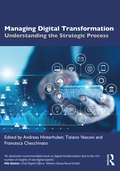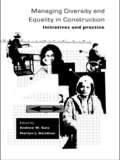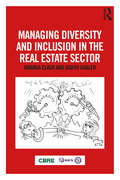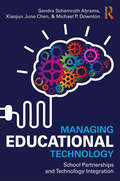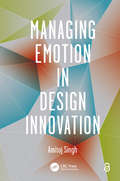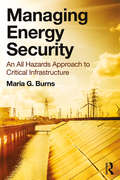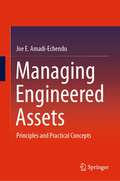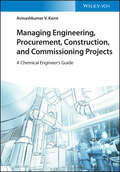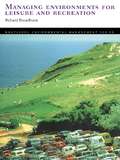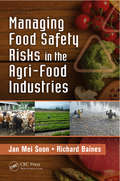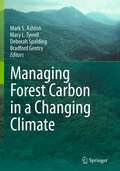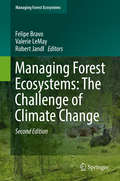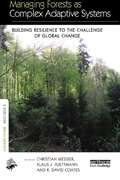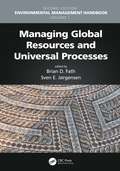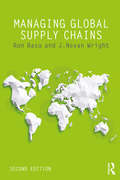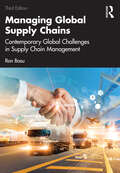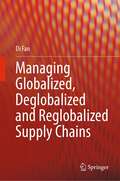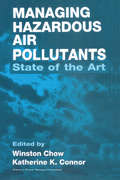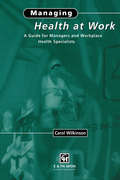- Table View
- List View
Managing Digital Transformation: Understanding the Strategic Process
by Andreas HinterhuberThis book provides practising executives and academics with the theories and best practices to plan and implement the digital transformation successfully. Key benefits: an overview on how leading companies plan and implement digital transformation interviews with chief executive officers and chief digital officers of leading companies – Bulgari, Deutsche Bahn, Henkel, Lanxess, L’Oréal, Unilever, Thales and others – explore lessons learnt and roadmaps to successful implementation research and case studies on the digitalization of small and medium-sized companies cutting-edge academic research on business models, organizational capabilities and performance implications of the digital transformation tools and insights into how to overcome internal resistance, build digital capabilities, align the organization, develop the ecosystem and create customer value to implement digital strategies that increase profits Managing Digital Transformation is unique in its approach, combining rigorous academic theory with practical insights and contributions from companies that are, according to leading academic thinkers, at the forefront of global best practice in the digital transformation. It is a recommended reading both for practitioners looking to implement digital strategies within their own organisations, as well as for academics and postgraduate students studying digital transformation, strategy and marketing.
Managing Diversity and Equality in Construction: Initiatives and Practice
by Marilyn J. Davidson Andrew W. GaleWith women in the UK construction industry constituting just thirteen per cent of the workforce and black and Asian workers numbering less that two per cent, despite representing more than six per cent of the working population, diversity is a problem that the construction industry needs to tackle directly. In this title, diversity management is presented as an opportunity for the construction industry. Work is presented from several different countries and regions, in North America, Australia and Europe to provide a comprehensive picture of this complex and often sensitive issue. Going beyond the traditional topics of gender and racial discrimination contributions encompass a wide range of diversity issues facing the construction industry, including sexual orientation, disability and the work-life balance. Essential reading for construction managers and a valuable resource for post-graduate researchers, this key title provides not only a thorough exposition of contemporary research but also supplies the practical diagnostic tools, and techniques to successfully manage diversity in construction and the information to adhere to the law.
Managing Diversity and Inclusion in the Real Estate Sector
by Amanda Clack Judith GablerResearch shows that high-performing organisations focus on diversity and inclusion (D&I). In any workplace, it is important to both understand and recognise the benefits that having a D&I workforce provides. It is integral to developing people within an organisation, serving clients as best we can, and playing an important leadership role in communities. This book is the first to place D&I at the centre of successful real estate and construction organisations. It provides guidance to, and most importantly, actions for professionals in the sector who want to make D&I an inherent part of the culture of their organisation. This book has been written to bring the sector up to speed with what D&I is all about and how a D&I strategy can be implemented to secure future success. It presents a practical and easy-to-read guide that can help organisations and their leaders engage with and apply this agenda to win the war for talent in real estate and construction. This book is essential reading for all property leaders and professionals working in the real estate and construction sectors. Readers will gain especially from personal reflections on all aspects of diversity by a broad range of people working in the property industry.
Managing Educational Technology: School Partnerships and Technology Integration
by Sandra Schamroth Abrams Xiaojun June Chen Michael P. DowntonManaging Educational Technology: School Partnerships and Technology Integration by Sandra Schamroth Abrams, Xiaojun June Chen, and Michael P. Downton. Sandra Schamroth Abrams is an associate professor in the Department of Curriculum and Instruction at St. John’s University, USA. Xiaojun Chen is an associate professor of educational technologies in the Department of Curriculum and Instruction at St. John’s University, USA. Michael P. Downton is an assistant professor in the Department of Curriculum and Instruction at St. John’s University, USA.
Managing Emotion in Design Innovation
by Amitoj SinghThis book presents an emotion centered research framework titled "emoha" for design innovation. It defines emoha and underlines the importance of the developed framework in culturalization of technology and thereby design innovation. The book explains the detailed research on product styling which leads to the creation of "Emoha" and how to use it in product design.
Managing Energy Security: An All Hazards Approach to Critical Infrastructure
by Maria G. BurnsThis interdisciplinary book is written for government and industry professionals who need a comprehensive, accessible guide to modern energy security. Introducing the ten predominant energy types, both renewable and non-renewable, the book illustrates the modern energy landscape from a geopolitical, commercial, economic and technological perspective. Energy is presented as the powerhouse of global economic activities. To ensure the uninterrupted supply of energy, nations, industries and consumers need to have options. Efficient energy security planning ensures that when a primary energy source is depleted, compromised or interrupted, an alternative energy source must be readily available. For this reason, the foundations of energy security are built upon the five pillars of Sustainability, Independence, Efficiency, Affordability and Accessibility. The numerous case studies presented in this book demonstrate that energy security may be compromised in the absence of one out of these five ingredients. The book also entertains the Triple-E notion of Energy Efficiency, Environmental integrity and Economies of scale, used by governments and corporations for energy optimization. One of the key strengths of the book is its ability effectively to cover various scientific disciplines, and several energy types, while remaining comprehensible. This book will be of much interest to security or logistics professionals, economists and engineers, as well as policymakers.
Managing Energy, Nutrients, and Pests in Organic Field Crops (Integrative Studies in Water Management & Land Development)
by Ralph C. Martin Rod MacRaeThe use of organic management practices in field cropping continues to rise globally, and these methods have proven to be a viable way to produce food with reduced resource use and environmental damage. Managing Energy, Nutrients, and Pests in Organic Field Crops challenges the popular misconception that organic systems are weak at managing energy,
Managing Engineered Assets: Principles and Practical Concepts
by Joe E. Amadi-EchenduThis textbook deals with engineering, science, technical, legal, financial, ICT, logistics and people management topics necessary for managing engineered assets such as all man-made tools, gadgets, buildings, equipment, machines, infrastructure, large-scale physical and industrial facilities and systems which pervade all sectors of industry. By coalescing concepts, principles, practices, and practical issues from the relevant multi-disciplines, the book addresses the body of knowledge required for managing engineered assets in the 4IR and Society 5.0 era and beyond.The book is written for:Scholars and students who intend to strengthen or acquire knowledge about the concepts, principles, and practice of managing engineered assets;Managers of engineered assets in both the public and private sectors who aim to improve asset management practice for their organisational purposes and missions;Policymakers and regulators in order to improve policymaking, governance, assessment and evaluation frameworks on the management of engineered assets;The broader audience concerned about the sustainable management of engineered assets that constitute our built environment and provide the means for industry and livelihood.
Managing Engineering, Procurement, Construction, and Commissioning Projects: A Chemical Engineer's Guide
by Avinashkumar V. KarreManaging Engineering, Procurement, Construction, and Commissioning Projects An invaluable real-world guide to managing large-scale and complex Engineering, Procurement, Construction and Commissioning (EPCC) projects Engineering, Procurement, Construction and Commissioning (EPCC) infrastructure projects require engineers from several disciplines to adhere to strict budgetary, scheduling, and performance parameters. Chemical engineers involved in EPCC projects are involved primarily in ensuring that the process plant is designed correctly and safely—interacting with the client, contributing to feasibility studies, selecting specific technologies, developing process flow diagrams, and other key tasks. Managing Engineering, Procurement, Construction, and Commissioning Projects: A Chemical Engineer’s Guide clearly defines the role of a chemical engineer in the EPCC industry and provides detailed and systematic coverage of each phase of an EPCC project. Drawing from their extensive experience in process design, optimization, and analysis, the author identifies and discuss each key task and consideration from a chemical engineer’s perspective. Topics include scope and process planning, construction support, operator training, safety and viability evaluation, and detail engineering. Provides a structured overview of the various challenges chemical engineers face in each project phase Introduces the essential aspects of the Engineering, Procurement, Construction and Commissioning industry Describes the roles of chemical process engineers in each phase of EPCC projects and in different EPCC industry positions Discusses the interaction of process engineers with other disciplines and clients Managing Engineering, Procurement, Construction, and Commissioning Projects: A Chemical Engineer’s Guide is a must-have resource for chemists in industry, process engineers, chemical Engineers, engineering consultants, and project managers and planners working on EPCC projects across the chemical Industry.
Managing Environments for Leisure and Recreation
by Richard BroadhurstCan we balance the needs of the host, the environment and the visitor?Most people live for their leisure, recreation and travel opportunities. Managing Environments for Leisure and Recreation seeks to bring together the different strands of thought that inform the management of settings, for leisure and recreation. The text shows how a positive difference can be made to such activities, by taking a balanced approach in managing for the environment and for people, both now, and into the future.Managing Environments for Leisure and Recreation urges managers to balance the need for a systematic approach, with the need for a systemic development of an environmental management ethic. It is highly illustrated with over 50 line drawings and includes many case studies from around the world.
Managing Flood Risk: Innovative Approaches From Big Floodplain Rivers And Urban Streams
by Scott Nicholson G. Mathias Kondolf Anna Serra-Llobet Kathleen SchaeferThe past half century has seen an evolution in thinking from ‘flood control’ to ‘flood risk management’, recognizing that risk results from both hazard and vulnerability. Rather than rely only on engineering structures to reduce flood magnitude or extent, recent policies emphasize avoiding construction in flood-prone areas (or moving people from floodplains), reducing impacts on exposed populations through early warning systems, and insurance to aid in recovery. Implementing this new approach faces many challenges but also offers opportunities for synergies, as described in this book for a range of large floodplain rivers and smaller urban streams across North America and Europe. This book is unique in presenting the voices of those on the front lines of implementing a new paradigm in flood risk management, each river with a unique set of challenges and opportunities derived from its specific geography as well as differences in governance between the American and European contexts.
Managing Food Safety Risks in the Agri-Food Industries
by Richard Baines Jan Mei SoonModern farming practices involve more stakeholders in the supply chain, presenting issues of storage, transportation, and distribution prior to reaching the consumer. This increasing complexity in food production chains creates more points for introducing microorganism contamination of crops, livestock, and aquatic organisms. Managing Food Safety R
Managing Forest Carbon in a Changing Climate
by Mark S. Ashton Mary L. Tyrrell Bradford Gentry Deborah SpaldingThe aim of this book is to provide an accessible overview for advanced students, resource professionals such as land managers, and policy makers to acquaint themselves with the established science, management practices and policies that facilitate sequestration and allow for the storage of carbon in forests. The book has value to the reader to better understand: a) carbon science and management of forests and wood products; b) the underlying social mechanisms of deforestation; and c) the policy options in order to formulate a cohesive strategy for implementing forest carbon projects and ultimately reducing emissions from forest land use.
Managing Forest Ecosystems: The Challenge of Climate Change
by Robert Jandl Felipe Bravo Valerie LemayClimate change shaped the political agenda during the last decade with three issues as hot topics: commonly making the headlines: carbon budgets, impact and mitigation of climate change. Given the significant role that forests play in the climate system - as sources, sinks, and through carbon trading - this book update the current scientific evidences on the relationships between climate, forest resources and forest management practices around the world. By including the forest scientists' expertise from around the world, the book presents and updates a depth analysis of the current knowledge, and a series of case studies focused on the biological and the economic impacts of climate change in forest ecosystems in Africa, Asia, Europe and North and South America. The book will form a valuable resource for researchers and advanced students dealing with sustainable forestry, climate change issues and the effects of climate change on natural resource management.
Managing Forests as Complex Adaptive Systems: Building Resilience to the Challenge of Global Change (The Earthscan Forest Library)
by Christian Messier K. David Coates Klaus J. PuettmannThis book links the emerging concepts of complexity, complex adaptive system (CAS) and resilience to forest ecology and management. It explores how these concepts can be applied in various forest biomes of the world with their different ecological, economic and social settings, and history. Individual chapters stress different elements of these concepts based on the specific setting and expertise of the authors. Regions and authors have been selected to cover a diversity of viewpoints and emphases, from silviculture and natural forests to forest restoration, and from boreal to tropical forests. The chapters show that there is no single generally applicable approach to forest management that applies to all settings. The first set of chapters provides a global overview of how complexity, CAS and resilience theory can benefit researchers who study forest ecosystems. A second set of chapters provides guidance for managers in understanding how these concepts can help them to facilitate forest ecosystem change and renewal (adapt or self-organize) in the face of global change while still delivering the goods and services desired by humans. The book takes a broad approach by covering a variety of forest biomes and the full range of management goals from timber production to forest restoration to promote the maintenance of biodiversity, quality of water, or carbon storage.
Managing Global Resources and Universal Processes (Routledge Studies in Environmental Migration, Displacement and Resettlement)
by Brian D. Fath Megan Cole Sven E. JørgensenBringing together a wealth of knowledge, Environmental Management Handbook, Second Edition, gives a comprehensive overview of environmental problems, their sources, their assessment, and their solutions. Through in-depth entries and a topical table of contents, readers will quickly find answers to questions about environmental problems and their corresponding management issues. This six-volume set is a reimagining of the award-winning Encyclopedia of Environmental Management, published in 2013, and features insights from more than 500 contributors, all experts in their field. The experience, evidence, methods, and models used in studying environmental management are presented here in six stand-alone volumes, arranged along the major environmental systems. Features The first handbook that demonstrates the key processes and provisions for enhancing environmental management Addresses new and cutting-edge topics on ecosystem services, resilience, sustainability, food–energy–water nexus, socio-ecological systems, and more Provides an excellent basic knowledge on environmental systems, explains how these systems function, and offers strategies on how to best manage them Includes the most important problems and solutions facing environmental management today In this first volume, Managing Global Resources and Universal Processes, the reader is introduced to the general concepts and processes used in environmental management. As an excellent resource for finding basic knowledge on environmental systems, it reflects an extensive coverage of the field and includes the most important problems and solutions facing environmental management today. This book practically demonstrates the key processes, methods, and models used in studying environmental management.
Managing Global Supply Chains
by Ron Basu J. Nevan WrightStarting from the concept that "there is no point driving a Ferrari in a traffic jam", Basu and Wright demonstrate the importance of good supply chain management in Managing Global Supply Chains. Building on the successful Total Supply Chain Management and incorporating the new challenges of globalisation, this book demonstrates the practical tools and techniques that add value, deliver cost reduction and improve customer satisfaction. This new edition has been substantially revised and extended to include a holistic approach, incorporating the upstream suppliers and the downstream customers. Further updates to this edition include: New chapters on e-business, emerging markets, sustainability and green issues, global supply chains for services and event management, retail management and major project management A section of brand new case studies A new companion website to support lecturers with their teaching This book also provides comprehensive insight into lean and agile supply chains supported by tools, techniques and case examples. Managing Global Supply Chains is a practical text with excellent coverage and is ideal for post-experience business students or learning professionals in supply chain management.
Managing Global Supply Chains: Contemporary Global Challenges in Supply Chain Management
by Ron BasuWhat are the key factors affecting global supply chains today and how can we manage them? Starting from the concept that 'there is no point driving a Ferrari in a traffic jam', Ron Basu provides practical tools and techniques of good supply chain management to add value, deliver cost reduction and improve customer satisfaction. This new edition specifically focuses on seven contemporary challenges that have affected global supply chain management. Recent disruptions to global supply chains created by COVID-19 and the Ukraine conflict have resulted in significant geographical shifts in supply and demand. High inflation and the cost of living crisis have, in turn, created problems for finely-tuned global supply chains. The economic and business environment has also become more demanding, due in part to political pressures including nationalism and Brexit: for example, supply chain pressures caused by Brexit have resulted in increased red tape. Other factors have had a gradual and positive effect, such as climate change initiatives, Industry 4.0 and the digital revolution. The issues that affect the performance of global supply chains are sometimes interrelated, but all of them really matter because businesses have become increasingly global. This book addresses these challenges and explores how to deal with them. In addition, there are new and updated chapters on lean and agile supply chains, e-business, emerging markets, sustainability and green issues, global supply chains for services and event management, retail management and major project management. Managing Global Supply Chains is a practical and highly readable text with real-life examples and excellent coverage. It is an ideal companion for post-experience business students, learning professionals and anyone interested in supply chain management.
Managing Globalized, Deglobalized and Reglobalized Supply Chains
by Di FanThis book provides an in-depth exploration of the complexities surrounding supply chain globalization, de-globalization, and the prospective re-globalization. It not only presents the interplay of these phenomena but also navigates their root causes through the lens of organizational, economic and political theories. The analysis spans across multiple fields, enabling readers to grasp the full breadth and depth of the dynamics at play. In this book, you'll delve into the intricacies of global sourcing and production. These discussions will help you understand the layers of complexities inherent in managing global supply chains. You'll explore the risks and uncertainties associated with international supply chain operations, gaining insight into building resilient and adaptive systems capable of thriving amidst constant change. You'll also learn about the sustainability challenges emerging within the global supply chain environment. How can firms ensure that their supply chains remain economically viable, socially responsible, and environmentally friendly? These and other topics find their discussions in the pages of this book. This book offers considerable value for various readers. Students at both undergraduate and postgraduate levels can gain essential understanding of concepts and phenomena related to supply chain globalization. Operational managers can find practical implications and strategies for managing their global supply chains amidst an unpredictable international trade environment. Finally, the book doesn't only focus on the present. It forecasts potential future developments and proposes new research directions in the fields of supply chain management, strategic management, and international business. Thus, it's also an indispensable resource for scholars seeking fresh perspectives and avenues for exploration.
Managing Hazardous Air Pollutants: State of the Art
by Winston Chow Katherine ConnorManaging Hazardous Air Pollutants presents a detailed examination of the state-of-the-art in the management of air pollutants ("air toxics"). This important new volume focuses on the latest research, regulatory perspectives, modeling, environmental and human risk assessments, new control strategies, monitoring programs, risk communication, and risk management. Key chapters in the book are devoted to these timely subjects:
Managing Health at Work: A Guide for Managers and Workplace Health Specialists
by C. WilkinsonManaging Health at Work reviews recent developments in the field of workplace health from a practical point of view. It is aimed at managers and health specialists concerned with initiating new policies to develop and improve workplace health. The book provides essential guidance in managing health at work, gives specific examples of good practice and alerts the reader to relevant guidelines surrounding issues such as stress, cancer, HIV and AIDS, RSI, health eating and exercise. The author argues that increasing attention should be paid to the use of workplace health especially with the growing number of employees making claims against their employers for a wide range of health problems.
Managing Health, Safety and Well-Being: Ethics, Responsibility And Sustainability (Aligning Perspectives On Health, Safety And Well-being Ser.)
by Stavroula Leka Aditya Jain Gerard I.J.M. ZwetslootTo achieve sustainable progress in workplace and societal functioning and development, it is essential to align perspectives for the management of health, safety and well-being. Employers are responsible for providing every individual with a working environment that is safe and does not harm their physical or mental health. However, the current state of the art indicates that approaches used to promote health, safety and well-being have not had the anticipated results. At the level of the enterprise it is widely understood and accepted by all stakeholders that employers share the responsibility of promoting and managing the health of their workers. Evidence indicates that most employers put in place procedures and measures to manage workers’ health and create healthy workplaces to meet legal requirements, as a response to requests by employees, as a need to improve company image/reputation, and to improve productivity. This highlights that in addition to legal requirements, the key drivers for companies also include the ethical and business case. While much has been written about role of legislation and the business case for promoting health, safety and well-being, not much is known about the ‘ethical case’ for promoting employment and working conditions. In this context, this book examines the potential of the link between responsible and sustainable workplace practices, human rights and worker health, safety and well-being and explores how complementary approaches can be used to promote employment and working conditions and sustainability at the organizational level. It offers a framework for aligning different approaches and perspectives to the promotion of workers’ health, safety and well-being and provides recommendations for introducing such an approach at the enterprise level.
Managing Human and Social Systems
by Brian D. Fath Sven E. JørgensenBringing together a wealth of knowledge, Environmental Management Handbook, Second Edition, gives a comprehensive overview of environmental problems, their sources, their assessment, and their solutions. Through in-depth entries and a topical table of contents, readers will quickly find answers to questions about environmental problems and their corresponding management issues. This six-volume set is a reimagining of the award-winning Encyclopedia of Environmental Management, published in 2013, and features insights from more than 400 contributors, all experts in their field. The experience, evidence, methods, and models used in studying environmental management are presented here in six stand-alone volumes, arranged along the major environmental systems. Features The first handbook that demonstrates the key processes and provisions for enhancing environmental management Addresses new and cutting-edge topics on ecosystem services, resilience, sustainability, food–energy–water nexus, socio-ecological systems, and more Provides an excellent basic knowledge on environmental systems, explains how these systems function, and offers strategies on how to best manage them Includes the most important problems and solutions facing environmental management today In this sixth volume, Managing Human and Social Systems, the reader is introduced to the general concepts and processes of all the environmental tools and their application to human and social systems. It explains how these systems function and provides strategies on how to best manage them. It serves as an excellent resource for finding basic knowledge on the human and social systems and includes important problems and solutions that environmental managers face today. This book practically demonstrates the key processes, methods, and models used in studying environmental management.
Managing Indoor Environments and Energy in Buildings with Integrated Intelligent Systems
by Triantafyllia Nikolaou Dionysia Kolokotsa George Stavrakakis Apostolos Apostolou Corneliu MunteanuFeaturing a detailed analysis and presentation of innovative researches, methods, algorithms and technologies that deal with integrated intelligent systems for the efficient management of energy and indoor environment in buildings, this book encompasses the regulations, directives and standards regarding the energy and the indoor environment of buildings as well as a literature review and discussion on the current state-of-the-art for buildings' energy efficiency classification. Maximizing reader insight into this topic with the aid of simulation models for buildings and energy audits at office buildings are presented including tables and figures with the detailed information regarding the parameters, inputs, outputs and the outcomes of the surveys. This book also outlines the development of a Virtual Building Dataset (VBD) of office buildings as an innovative benchmarking and classification tool. The proposed methodology overcomes the difficulties and time required for collecting the necessary massive building constructional and energy bills data by creating them virtually using efficient stochastic simulation and by taking into account all parameters that may affect the energy performance and indoor thermal comfort of office buildings. The knowledge and ideas conveyed by the book are supported with equations and algorithms and 137 colored figures and 55 tables, and features a rich bibliography, references and web sources. The book contains the basic knowledge undergraduate and especially postgraduate courses on the emergent subject of energy management and saving in buildings. The innovative aspects and guides of the book give serious opportunities to the postgraduate students in this scientific area to further develop their research skills and capabilities.
Managing Industrial Hazardous Waste- A Practical Handbook
by Gary F. LindgrenHere is your new handbook full of information and guidance necessary to understand and comply with the myriad and complex hazardous waste regulations. This handbook explains the regulations regarding identification and listing of hazardous wastes, walks the reader through the three determinations for all manufacturing firms, gives in-depth explanations of applicable standards, outlines the DOT standards applicable to shippers of hazardous wastes, presents a philosophical basis for corporate compliance, gives "how to" for actions and the paperwork necessary for such a program, and concludes with some practical information not commonly found in textbooks or regulations. This essential resource for personnel with waste management responsibilities at manufacturing firms should prove a valuable resource. This book will assist these practitioners in establishing or modifying regulatory compliance programs. This valuable new book helps you to reduce waste generation, segregate hazardous wastes, reuse on-site or off-site, recycle or reclaim, treat to reduce hazards, secure land disposal, follow regulatory standards, use best management practices, and establish or modify compliance programs.
